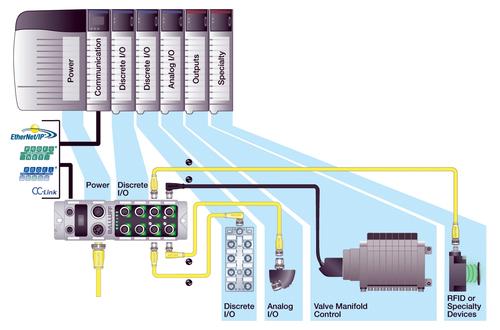Smart Sensor Connectivity Gets IO-Link Boost
October 13, 2011

Smart sensors used for measurement are becoming crucial enablers in almost every industry, not only for machine control but also for greater networking and data connectivity. While Ethernet has infiltrated nearly every level of factory networking, the size and cost of the technology is too much for these simple devices.
With an emphasis on using network communications to provide automated parameter setting and expanded diagnostics, IO-Link technology is emerging to provide a potent solution for many types of sensors. Backed by a large and diverse consortium of industrial control suppliers, the technology provides a simple, low-cost alternative and is moving toward widespread, and potentially global, acceptance.
"The connectivity trend we see with smart sensors is related to IO-Link," says Jeff Allison, product manager of photoelectric sensing for Pepperl + Fuchs. "IO-Link is the result of a consortium of companies coming together, and we think it is going to change the way people use sensors in the future."

IO-Link is a point-to-point communication topology which allows users to configure a sensor, perform diagnostics, and receive process data. Users can retrieve distance information, such as the distance from a sensor to an object for positioning purposes or to measure the dimensions of a carton, pallet, or box.
Allison says that IO-Link opens up new possibilities compared to older sensors that basically provided on/off and limited configuration possibilities. Typical systems usually had two switches or pushbuttons for adjusting the distance and turning the sensor from "light on" to "dark on." But with IO-Link, the user can adjust more than a dozen parameters and get valuable information, from distance data to the optical strength of the signal being reflected back.
"Users can change the function of the status LEDs to better suit the application, change how the sensor measures the signal, and the number of samples it takes," Allison says.
"If there is an unstable system with some vibration, the user can increase the samples of the reflected light energy that comes back to the receiver and produce a more stable signal. On the other hand, some people have a stable system and want faster response, so they will choose to decrease the sampling rate. It provides an unparalleled level of control and configuration that we haven't had with a standard I/O device to date."
Pepperl + Fuchs is offering two new technologies for photoelectric measurement sensing that use IO-Link: pulse ranging technology (PRT) and multi-pixel array (MPA) sensing.
PRT technology uses a laser that emits intense bursts of light directed at an object or reflector. That light is reflected back to the sensor's receiver or light-sensitive element and makes it possible to use the speed of light as a constant to calculate very precisely how far the object is away from the sensor.
About the Author(s)
You May Also Like





